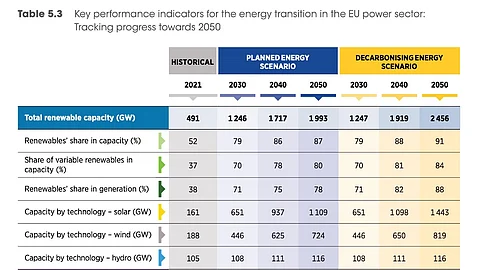

IRENA warns that the EU is not on track to meet its 2030 renewable energy and emissions goal
It recommends fast-tracking renewable energy installations, particularly solar PV and wind, to achieve decarbonization
Annual solar PV installations in the EU need to expand from 56 GW in 2023 to 73 GW/year
The transition, including investments in related infrastructure, will require €5.6 trillion investment by 2050
The European Union (EU) needs to install an average of 122 GW of renewable energy/year over 2025-2050 to meet its targets to achieve about 70% of electricity from renewables by 2030, and nearly 90% by 2050. However, the International Renewable Energy Agency (IRENA) finds that the bloc is not on track to meet its short-term renewable energy and emissions targets for 2030.
By 2030, the EU has committed to achieving at least 42.5% of its gross final energy consumption from renewable energy, going up to 45% under the revised Renewable Energy Directive (RED) (see EU Settles For 42.5% RE Target For 2030).
It needs to deploy a minimum of 1,100 GW of new wind and solar capacity with corresponding grid expansion to expand the total renewables capacity to 1,247 GW by 2030. By 2040, this should increase to nearly 1,800 GW to reach 1,919 GW, respectively. To achieve a 91% renewable energy share in total power capacity, the bloc will need to expand wind and solar capacity to almost 2,300 GW by 2050, scaling up total renewables capacity to 2,456 GW.
It would also need to deploy at least 45 GW of battery storage capacity by 2030, integrate over 230 GW by 2040, and over 240 GW by 2050.
To achieve these projected volumes in the report’s Decarbonising Energy Scenario (DES), annual solar installations will need to grow by 73 GW annually until 2050, growing significantly from the 56 GW reported for 2023 (see EU Solar PV Installations Reach 56 GW In 2023).
That’s when it will triple by 2030 from 161 GW in 2021 to 651 GW, dominating the renewable energy mix, reaching 1,443 GW by 2050. In comparison, under PES, solar PV’s total installed capacity will reach 1,109 GW.
Solar PV also dominates renewable technology investments, reaching €273 billion (2025-2030) under both DES and Planned Energy Scenario (PES), then declining to €205 billion (DES) and €140 billion (PES) for 2031-2040, and culminating at €262 billion (DES) and €217 billion (PES) by 2050, reads the report.
“Faster grid expansion, integration and regional planning are essential to unlock this transition and avoid bottlenecks,” reads IRENA’s 1st Regional Energy Transition Outlook for EU.
It argues that the bloc needs to fast-track clean energy deployment while ensuring energy system stability for the energy transition. However, it would need €5.6 trillion investment in power sector capacity and infrastructure improvement by 2050, or an average of €220 billion annually, representing nearly a 50% increase over current levels.
Nevertheless, the benefits of boosting renewables outweigh these challenges as it will ensure affordable electricity at stable prices, lower wholesale prices, reduced exposure to fossil fuels, and a decarbonized energy system.
Timely implementation across EU Member States remains a major challenge, for which the report calls for integration and coordinated energy planning.
“Investing in the energy transition within the EU is a no-regrets option,” said IRENA Director-General Francesco La Camera. He stressed that “the EU economy could grow by 2% annually until 2050 and boost energy sector jobs to nearly 8 million within this decade. By placing low-cost renewables at its heart, the transition can enhance energy independence and deliver affordable, sustainable energy to industry, households, communities, and citizens across the EU.”
Additionally, IRENA stresses the need for stable energy systems, climate-resilient infrastructure, cybersecurity measures, and accelerated innovation in storage and flexibility solutions to ensure a resilient, competitive power sector.
The complete IRENA report is available for free download on its website.
